Focus 2010 Goal: Create a learning community that supports and encourages the engagement of its members in active learning.
Index
- First-year experience
- Culture of affirmation
- AOD efforts
- Katrina clean up
- Construction class redesigns game room
- M3C Fellowship Program
- Math Center
- Turtleback jacket project
- Freedom fridge (CID)
- Adjustable cooktop invention (SVRI)
- Zebrafish research
- C-NERVE project
First-year experience
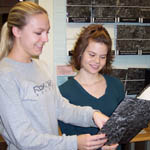 UW-Stout has instituted a First-Year Experience program, which includes Living and Learning Communities. A group of students with similar academic majors become cohorts and enroll in two or three courses together. Most students also live in the same residence hall. The learning community supports field trips, seminars, service-learning programs or other activities related to the goals of the community.
UW-Stout has instituted a First-Year Experience program, which includes Living and Learning Communities. A group of students with similar academic majors become cohorts and enroll in two or three courses together. Most students also live in the same residence hall. The learning community supports field trips, seminars, service-learning programs or other activities related to the goals of the community.
Culture of affirmation
To increase student learning and engagement, UW-Stout ensures a culture of affirmation that enhances an engaging and supportive environment inside and outside the classroom. In 2005-06, the university showcased the best practices in teaching, learning and engagement; participated in the Student Engagement Study; and developed a statement of affirmation.
A culture of affirmation fosters a collegial, trusting and tolerant campus climate. Such a culture is seen as respectful, engaging, welcoming, inclusive, enjoyable, collaborative and intellectually stimulating.
AOD efforts
Dunn County, the city of Menomonie and UW-Stout are state leaders when it comes to intervention, referral and educational programming for youth alcohol abuse. Ongoing community and university coalitions work to reduce youth drinking and stop adults from supplying alcohol. Support for campus prevention activities is strong, and a clear message is conveyed by the chancellor, campus police, residence hall staff and faculty in the classroom.
Activities in the past year include distributing alcohol-free Super Bowl party packs in residence halls, working with the Dunn County Partnership for Youth to develop community briefings, and developing online self-evaluation tools for student use.
Among UW-Stout students, 24 percent self-report not consuming any alcohol, up from 20 percent one year ago.
Katrina clean up
A total of 86 students and four staff members from UW-Stout took an "Alternative Spring Break" trip in 2006 to Hancock County in Mississippi. where they helped rebuild the Gulf Coast suffering from the effects of Hurricane Katrina. In the mornings, the group removed debris and trees, hung sheetrock and made building repairs. In the afternoons, the students raised the spirits of Waveland’s children at the Boys and Girls Club through arts and crafts and games. In one week, the students clocked a combined total of more than 2,000 hours of work.
Construction class redesigns game room for Boys and Girls Club
Eighteen students in an architectural design class designed a youth game area for the Boys and Girls Clubs of the Greater Chippewa Valley. After meeting with club officials and touring the current facility, the students determined color schemes, floor plans and storage space options for the organization—all within the confines of a real-life budget.
Some of the suggested renovations, such as a trendy paint job and new carpeting, were selected to be implemented immediately. Pricier renovations will occur after the organization raises additional funds.
M3C
The Midwest Campus Compact Citizen-Scholar Fellowship Program, otherwise known as M3C Fellows, was offered at UW-Stout. The goal of the M3C Fellowship Program was to organize service-learning projects and to recruit UW-Stout students to contribute more than 3,000 volunteer hours Jan. 1-Dec. 31, 2006.
Projects included painting at a hockey rink, serving or cleaning up at various school district events, cleaning up at the Red Cedar Trail, giving campus life tours for disadvantaged students, assisting at Parent’s Night at Menomonie High School, assisting in nursing homes, and painting an apartment at Memorial Heights.
The M3C Fellows receive the distinction of an educational award from the National Service Trust of $1,000 toward their future college tuition. The M3C Citizen-Scholar Fellowship Program is one of many programming efforts Student Support Services uses to increase graduation rates.
Math Center
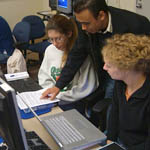 Since studies show that success in first-year math courses is a strong predictor of retention into the second year of college, UW-Stout annually invests approximately $55,000 in resources into its Math Teaching and Learning Center, or Math TLC, which serves 600-700 students per year.
Since studies show that success in first-year math courses is a strong predictor of retention into the second year of college, UW-Stout annually invests approximately $55,000 in resources into its Math Teaching and Learning Center, or Math TLC, which serves 600-700 students per year.
The lab is a technology-enhanced classroom dedicated to several sections of two first-year math courses, and it is staffed with trained tutors. Special software gives students immediate feedback and also 24/7 online help for each problem. Personal homework assistance is available in class daily, and instructors closely monitor students’ progress.
As a result, 95 percent of homework assignments are being completed, and the average homework score is 92 percent. Since the creation of Math TLC two years ago, non-pass rates dropped 61 percent in the remedial algebra course compared to the previous four-year average. Success rates also improved in intermediate algebra, a non-remedial course taught in the center, with a 23 percent reduction in failure and withdrawal rates despite higher standards instituted in 2004.
Turtleback Jacket project
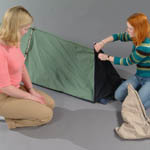 Four UW-Stout students created a garment that also becomes a wearable shelter. The patent-pending design is a jacket, snowsuit and tent. Their original idea was to give out the jackets at homeless shelters, but the target market also includes camping enthusiasts. A market feasibility test determined the product had a potential of $95 million in sales.
Four UW-Stout students created a garment that also becomes a wearable shelter. The patent-pending design is a jacket, snowsuit and tent. Their original idea was to give out the jackets at homeless shelters, but the target market also includes camping enthusiasts. A market feasibility test determined the product had a potential of $95 million in sales.
For their design, the students were named finalists in the 2005 Concept 2 Consumer apparel design competition sponsored by the American Association of Textile Chemists and Colorists. The students now are working with WiSys to develop a professional prototype.
Freedom fridge (CID)
The Center for Innovation and Development is working with an inventor from Chippewa Falls whose concept is a wheelchair-accessible refrigerator. Staff members of the center and the Stout Vocational Rehabilitation Institute conducted an evaluation of the original design, and concluded that a more universal approach would broaden the impact of the refrigerator. They began to focus on a consumer market that included people with disabilities and those not yet dealing with disabilities, such as elderly individuals.
As a result of working on the wheelchair-accessible refrigerator, center staff members are considering plans for an entirely accessible kitchen. Barrier-free construction endeavors such as this may alter the attitudes of manufacturers so that the needs of a population dealing with disabilities are considered.
Adjustable cooktop invention (SVRI)
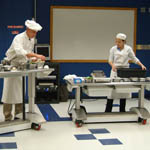 Researchers in the Stout Vocational Rehabilitation Institute, in collaboration with faculty and students in the College of Human Development, have developed a height-adjustable and mobile cooktop and food preparation table. The patent-pending system adjusts in elevation from 27 inches to 47 inches and rolls around a room. Its universal design meets the needs of 90 percent of users. Individuals from 4 feet 4 inches tall to 6 feet 7 inches tall can adjust the height of their cooktops for optimum comfort and safety.
Researchers in the Stout Vocational Rehabilitation Institute, in collaboration with faculty and students in the College of Human Development, have developed a height-adjustable and mobile cooktop and food preparation table. The patent-pending system adjusts in elevation from 27 inches to 47 inches and rolls around a room. Its universal design meets the needs of 90 percent of users. Individuals from 4 feet 4 inches tall to 6 feet 7 inches tall can adjust the height of their cooktops for optimum comfort and safety.
Typically, work surface heights in the food industry are 33 inches or 36 inches, which is ergonomically set for individuals who fall within the small range of 5 feet 6 inches and 5 feet 8 inches. Taller or shorter individuals can suffer from carpal tunnel syndrome or backaches over time.
Zebrafish research
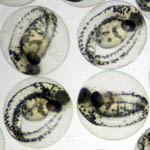 A UW-Stout assistant professor of biology believes that zebrafish have a number of characteristics that make them valuable models for scientific studies. Because zebrafish development occurs externally and the embryo is clear, the instructor and his students can watch development as it happens. Zebrafish develop from egg to embryo to free swimming juveniles in approximately three days, allowing fast results from experiments. And because zebrafish are vertebrate organisms, zebrafish findings may be applicable to humans. The research at UW-Stout centers on biotechnological innovations in genomics, tissue engineering, antisense-mediated gene therapy, computational biology and bioinformatics.
A UW-Stout assistant professor of biology believes that zebrafish have a number of characteristics that make them valuable models for scientific studies. Because zebrafish development occurs externally and the embryo is clear, the instructor and his students can watch development as it happens. Zebrafish develop from egg to embryo to free swimming juveniles in approximately three days, allowing fast results from experiments. And because zebrafish are vertebrate organisms, zebrafish findings may be applicable to humans. The research at UW-Stout centers on biotechnological innovations in genomics, tissue engineering, antisense-mediated gene therapy, computational biology and bioinformatics.
C-NERVE project
"C-NERVE: Cognitive-Neuroscience Education and Research-Valued Experience" is the title of a UW-Stout project funded by a $135,000 National Science Foundation Grant. The project focuses on undergraduate research in creating learning materials and teaching strategies; developing faculty expertise; implementing educational innovations; and assessing learning and evaluating innovations.
Learn more:
- First-Year Experience
- University Priority C: Culture of Affirmation [PDF]
- Alcohol and Other Drugs Program
- FAQ about Chancellor’s Coalition on Alcohol and Other Drugs
- Katrina cleanup: students choose no-alcohol spring break
- Citizen-fellowship program for students
- Math Teaching and Learning Center
- Patentable pattern
- The next idea
- Kitchens that measure up [PDF]
- Michael Pickart’s faculty page on zebrafish research
- C-Nerve
Published for the Chancellor's Office by the Office of University Communications
with assistance from the Office of Budget, Planning and Analysis.
